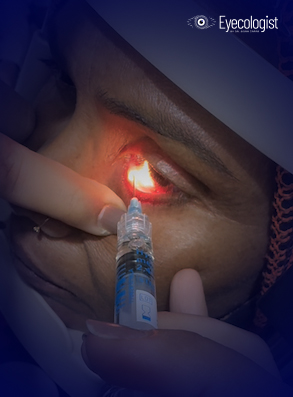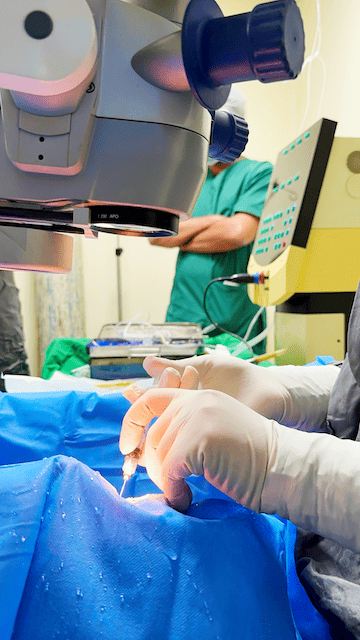Restoring Clarity, Preserving Independence
What are Eye Injections?
Intravitreal injections, commonly referred to as eye injections, are one of the most effective ways to treat sight-threatening conditions. By placing the medicine directly inside the eye, these injections deliver high doses exactly where they are needed, at the retina and inner structures of the eye.
Their main goal is to preserve vision by stopping disease progression. However, many patients also notice remarkable improvements in their ability to see.
Performed safely under numbing drops, eye injections are quick, well-tolerated, and highly effective. They play a vital role in protecting eyesight and maintaining quality of life.
The Need for Eye Injections
Eye injections are a highly effective treatment when certain eye diseases lead to swelling, fluid leakage, or the growth of abnormal blood vessels inside the eye. These injections deliver medicine directly where it is needed, helping to protect and preserve vision. They are most commonly recommended for:
- Diabetic eye disease (diabetic retinopathy, diabetic macular edema)
- Age-related macular degeneration (AMD)
- Choroidal neovascularization (abnormal blood vessels beneath the retina)
- Severe eye infections
- Serious eye inflammation
With early diagnosis and timely treatment, eye injections can significantly slow disease progression and reduce the risk of vision loss. The procedure is quick, safe, and usually well tolerated, offering patients an effective way to maintain clear and healthy eyesight.
Symptoms That May Require Eye Injections
Eye injections are often recommended when vision-threatening symptoms appear and need targeted treatment. If you experience any of the following, your eye specialist may suggest this approach to protect your sight:
- Blurred or distorted central vision
- Sudden or gradual loss of vision
- Dark spots or floaters interfering with vision
- Difficulty reading or recognizing familiar faces
- Eye pain, swelling, or redness caused by infection or inflammation
These symptoms may indicate serious underlying conditions such as diabetic eye disease, macular degeneration, or severe inflammation. Eye injections deliver medicine directly where it is needed most, helping control disease progression and reduce the risk of permanent vision loss.
Early consultation and timely treatment can make all the difference in preserving clear, healthy vision.

Eye Injections Treatment Procedure
Intravitreal injections are a safe and effective procedure designed to protect and preserve your vision. Here’s what you can expect during treatment:
- Sterile environment: The procedure is carried out in a sterile operating theatre.
- Comfort first: Anesthetic eye drops are applied to numb the eye.
- Precise delivery: A very fine needle gently injects the medication directly into the eye.
- Quick process: Most patients feel only mild pressure, and the procedure is completed within minutes.
- Aftercare: Your eye may be covered briefly with a patch, followed by a short course of antibiotic drops for one week.
The number and frequency of injections depend on your specific condition and how well your eye responds to treatment.
Recovery from Eye Injections
Recovery after eye injections is usually smooth and quick. Most patients experience little to no discomfort, but some mild effects may occur. Here’s what to expect and watch for:
- Fast recovery: Most patients feel well within hours.
- Mild side effects: Temporary irritation, slight redness, or light sensitivity may happen but usually resolve on their own.
- Aftercare tip: Avoid rubbing your eyes to ensure proper healing.
- Seek urgent care if you notice severe eye pain, significant swelling, or redness of the eyelid, sudden drop in vision, flashes of light, or new floaters.
Regular follow-up appointments are essential to track progress and determine if more injections are needed for long-term eye health.
Eye injections are more than treatment, they’re a step toward preserving independence and quality of life.
Eye injections are more than treatment, they’re a step toward preserving independence and quality of life.
Frequently Asked Questions About Eye Injections
Q1. Are eye injections painful?
No. Before the injection, your eye is numbed with anesthetic drops, so you won’t feel pain. Most patients report only mild pressure or slight discomfort.
Q2. How long does the procedure take?
The injection itself takes just a few minutes. With preparation and observation, the whole appointment usually lasts 1–2 hours.
Q3. How often will I need eye injections?
This depends on your condition. Some patients require monthly injections initially, while others may need fewer once the disease is controlled.
Q4. What happens after the injection?
You may experience temporary redness, irritation, or blurry vision for a few hours. Most patients return to normal activities by the next day.
Q5. Are eye injections safe?
Yes. Millions are performed worldwide each year. The risk of complications is very low, and your doctor will guide you on safety measures.
Q6. Can eye injections improve vision?
Yes. In many cases, injections not only prevent further vision loss but may also improve sight, especially in conditions like macular edema.
Q7. What precautions should I take after treatment?
- Use prescribed antibiotic drops as directed
- Avoid rubbing your eyes
- Report immediately if you notice severe pain, swelling or redness, sudden vision loss, flashes of light or new floaters.
Make an Appointment
Book Your Vision Journey Now

